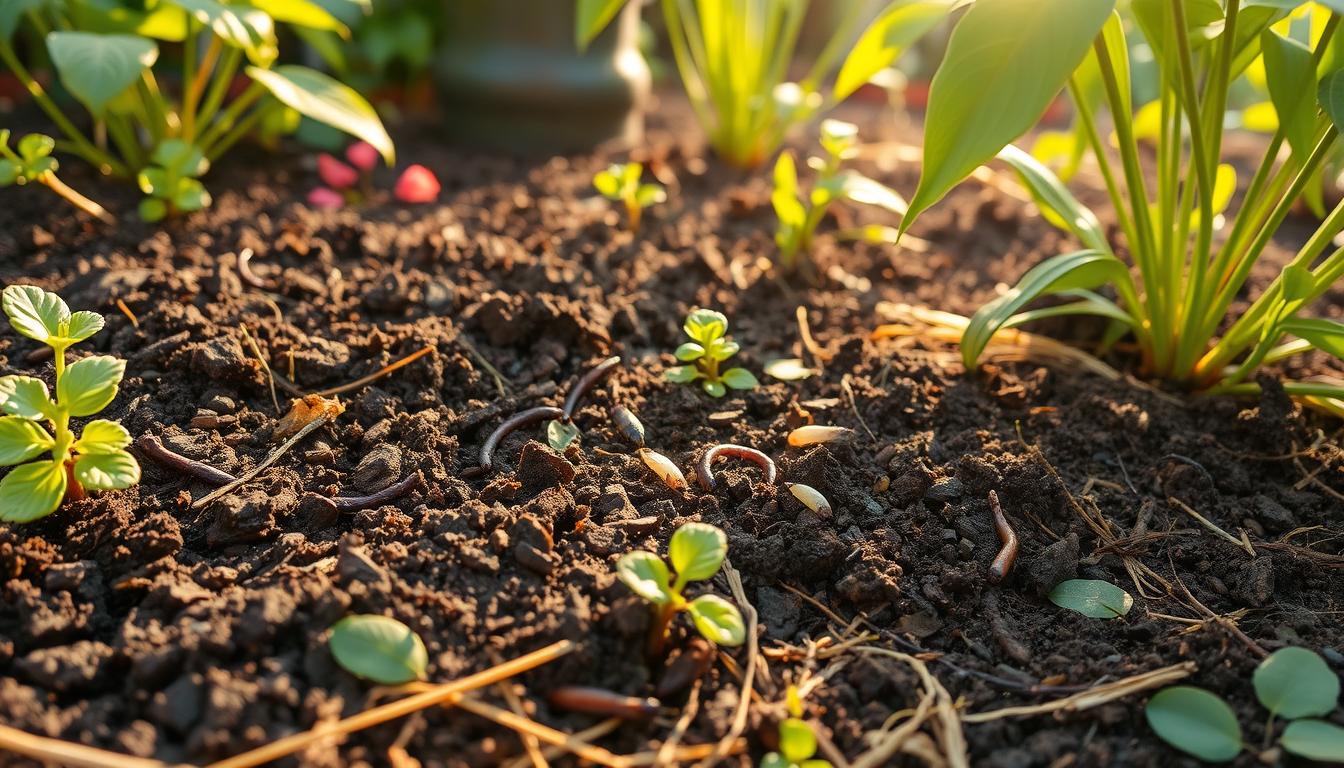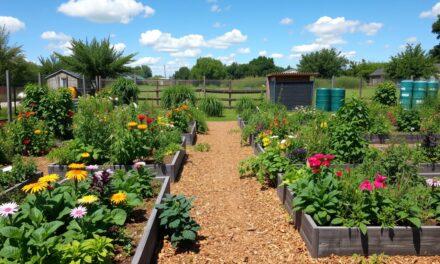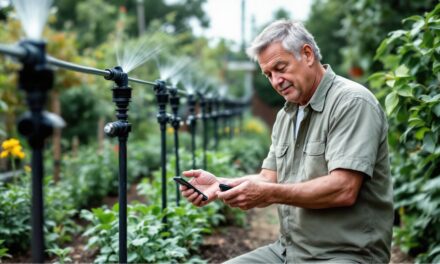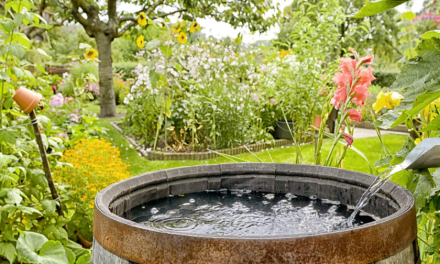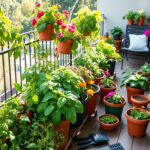My journey into eco-friendly gardening started with a simple idea. Every square foot of our garden can help heal the environment. I realized that the old ways of gardening, like using chemicals, didn’t match my growing love for nature.
Eco-friendly gardening is more than just a trend. It’s about caring for our planet through innovative, green practices. Using the proper techniques, our gardens can help local ecosystems and keep biodiversity alive by providing homes to animals like bees.
Choosing native plants is key to a sustainable garden. These plants need less care and fit right into their surroundings. By picking native plants, we can make our gardens healthier and easier to care for, saving up to 50% in some areas.
Water conservation is also vital in eco-friendly gardening. Methods like drip irrigation can reduce water use, and green landscaping can save 30-50% water compared to old sprinkler systems.
My eco-friendly gardening is all about creating balance. I aim to make my garden a haven for plants and animals alike. We can turn our gardens into true ecological wonders by making wise choices.
Understanding the Importance of Sustainable Gardening
Organic gardening is more than a trend. It’s a way to care for our planet. By changing how we garden, we can help our local ecosystems.
Environmental Impact of Traditional Gardening
Traditional gardening can damage our planet. It relies on excessive chemicals and is not sustainable. This adversely affects wildlife and degrades the soil.
Benefits of Eco-Friendly Practices
Organic gardening has significant benefits:
- It cuts down chemical use by up to 90%.
- It boosts local wildlife by 50%.
- It helps pollinators.
- It makes the soil better naturally.
Role in Climate Change Mitigation
My gardening helps fight climate change. I use native plants and save water, cutting use by 30-50%. Trees and organic methods also help capture carbon and support our environment.
Every garden is an opportunity to heal our planet, one plant at a time.
Organic gardening is not just for us. It’s a duty to protect our planet together.
Soil Health Management for Sustainable Gardens
Starting a thriving garden begins with the soil. Healthy soil is key for vigorous plant growth and caring for our planet. Using smart composting and soil care, gardeners can make their gardens more productive and kinder to the environment.
Sustainable Soil Management Techniques
Let’s look at essential ways to keep soil healthy:
- Develop a detailed composting plan.
- Use organic mulch.
- Add cover crops and green manure.
A sustainable gardening expert stated,
Soil is the foundation of life in your garden.
Composting is a big win for soil care. Healthy soil can make gardens up to 20% more productive. Turning kitchen and garden waste into compost adds nutrients that improve plant soil.
Soil Management Techniques and Benefits:
| Soil Management Technique | Potential Benefit |
| Composting | Recycle 30% of household waste. |
| Mulching | Reduce soil erosion by 80%. |
| Organic Matter Addition | Improve water retention by 25%. |
Start small with composting. Start by saving kitchen scraps and yard clippings. Patience is key in building rich, sustainable soil. Testing your soil regularly helps you know what it needs.
Using these composting and soil care methods, you can build a substantial, healthy garden that will support plant health and the well-being of our planet.
Water Conservation Techniques in Garden Design
Starting a sustainable garden means managing water wisely. This is good for the planet and saves money and effort. A well-designed garden can look great and use less water.
Water Conservation In Garden Design
There are many ways to cut down on water use in your garden. Drip irrigation systems are a top choice. They can save up to 50% of water compared to old ways of watering.
Efficient Irrigation Methods
Smart irrigation helps conserve water in your garden. Here are some helpful tips to improve water usage. This method makes gardening more sustainable and efficient.
Here are some tips:
- Install drip irrigation systems for targeted water delivery.
- Use smart controllers that adjust watering based on weather conditions.
- Group plants with similar water requirements together.
Rainwater Harvesting Systems
Collecting rainwater is a green way to water your garden. Rain barrels can reduce city water use by up to 40%. Strategic placement and proper filtration are key to maximizing these systems.
Drought-Resistant Landscaping
Choosing the right plants is key to saving water. Native plants need less water because they’re made for local weather. Mulching also helps keep water in the soil, reducing how often you need to water by up to 50%.
Water Conservation Techniques and Savings:
| Water Conservation Technique | Water Savings |
| Drip Irrigation | Up to 50%. |
| Rain Barrel Usage | 40% Reduction. |
| Native Plant Selection | 30-50% Less water. |
| Mulching | Up to 50% Less watering. |
Experts indicate that,
Water-wise gardening isn’t about limiting beauty, but about creating smarter, more resilient landscapes.
Gardeners can use these water-saving methods to create beautiful, lasting gardens that look great and use less water.
Native Plant Selection and Biodiversity
Starting an eco-friendly garden means understanding native plants. These plants fit perfectly in local environments, helping both gardeners and ecosystems. They use up to 50% less water than regular landscaping, making them a smart choice for gardens.
Native Plants Biodiversity
Native plants are true ecological heroes. They help local wildlife by attracting beneficial insects and supporting birds. Studies show gardens with 70% native plants can boost bird populations by over 50%.
- Support local pollinators.
- Require less maintenance.
- Conserve water resources.
- Enhance biodiversity.
Experts recommend that,
Native plants are the backbone of healthy ecosystems, providing essential support for local wildlife and environmental balance.
Choosing the right native plants can turn your garden into a thriving ecosystem. Milkweed, for example, is key for Monarch butterflies. Native species make landscapes strong and need little care.
Here’s a small table regarding that:
| Native Plant | Benefits | Water Savings |
| Little Bluestem | Drought Resistant | 40% Less Water |
| Butterfly Weed | Pollinator Attraction | 50% Less Water |
| Prairie Grasses | Soil Health | 45% Less Water |
By using native plants, we’re not just gardening. We’re helping restore ecosystems. These plants are a sustainable way to landscape, supporting local life and reducing environmental harm.
Eco-Friendly Pest Management Strategies
Gardening isn’t about getting rid of every insect. I’ve found that integrated pest management is more intelligent and keeps your garden healthy. Only a tiny fraction of insects are pests, about 0.1% to 1%. This method works with nature, not against it. It’s all about understanding and using the garden’s ecosystem.
Integrated Pest Management Garden
Integrated pest management (IPM) is a science-based approach to pest management. It goes beyond quick fixes to prevent problems before they start. This approach requires gardeners to consider how everything in the garden is connected.
Natural Pest Control Solutions
Here are some ways to manage pests naturally:
- Plant species that attract good insects.
- Keep your garden clean.
- Use row covers as barriers.
- Help natural predators.
Organic Fertilization Methods
To achieve sustainable fertilization, it’s essential to consider your soil’s ecosystem. Working in harmony with it can enhance plant health. For best results, consider integrating organic materials and monitoring soil health regularly.
I suggest:
- Composting waste.
- Using organic mulches.
- Adding natural amendments like bone meal.
Sustainable gardening principle,
Prevention is better than cure in garden management.
Sustainable Maintenance Practices
IPM needs patience and watching your garden closely. It involves five steps: inspect, identify, evaluate, act, and monitor. Knowing pest lifecycles helps create a balanced garden. This reduces the need for harmful chemicals. A few insects are okay. They’re part of a healthy garden.
Creating Wildlife-Friendly Garden Spaces
Turning your garden into a wildlife sanctuary is a big part of eco-friendly gardening. By making a space that helps local wildlife, you can make your backyard a lively ecosystem. Start by seeing how your garden helps local wildlife. Gardens are key homes for many creatures, from tiny bugs to small animals.
Here are ways to make your garden a wildlife paradise:
- Install bird feeders and birdbaths to attract local bird species.
- Plant nectar-rich flowers to support pollinators.
- Create shelter areas with native plants.
- Leave areas of unmown grass to provide habitats for insects and birds.
Think about adding special features for wildlife:
| Wildlife Feature | Benefits |
| Small Pond | Attracts dragonflies and amphibians. |
| Compost Heap | Provides habitat for minibeasts. |
| Hedgehog House | Offers nesting and hibernation spots. |
All experts have stated,
A garden is a complex ecosystem that can support an incredible diversity of life when designed thoughtfully.
You can create a good garden for the planet using these eco-friendly gardening tips. Every little thing you do helps keep our local wildlife safe.
Sustainable Materials and Tools
In my organic gardening journey, I’ve learned that the tools and materials we choose matter greatly. Choosing sustainable garden equipment is key for an eco-friendly garden. It supports plant health and helps the planet.
Eco-Friendly Garden Equipment
Traditional gas-powered tools harm the environment a lot. A gas lawnmower can pollute as much as driving a car for over 1,000 miles in just one hour. I suggest using electric or manual tools instead. They are better for the air and quieter.
- Electric tools with rechargeable batteries.
- Manual push mowers.
- Hand-powered pruning tools.
Recycled and Natural Materials
When picking materials for organic gardening, choose sustainable ones. Many nurseries recycle or reuse old plastic pots.
Here are some eco-friendly options:
| Material | Benefits |
| Coconut Coir | Sustainable potting medium. |
| Biochar | Improves soil structure. |
| Reclaimed Wood | Reduces deforestation impact. |
Reducing Plastic Usage
Plastic waste in gardening is a big problem. Switching to biodegradable options can cut garden plastic waste by over 70%. Look for biodegradable plant pots, labels, and packaging.
In organic gardening, every small choice contributes to a larger environmental impact.
We can make our gardens better for the planet by choosing sustainable tools and materials. They will also help our plants thrive.
Waste Reduction and Composting Practices
Turning garden waste into valuable compost is a big step toward eco-friendly gardening. Composting is the best way to recycle, turning kitchen scraps and yard trimmings into soil full of nutrients. By composting, gardeners can reduce landfill waste and make their gardens more sustainable.
Composting is more than just managing waste. It’s a way to help your garden grow strong. About 30% of household waste can be turned into compost, significantly benefiting the environment. This process transforms organic matter into dark, rich soil that feeds plants well.
- Collect green materials like grass clippings and food scraps.
- Mix with brown materials such as dry leaves and cardboard.
- Maintain a balanced ratio for optimal decomposition.
- Turn your compost pile regularly to speed up the process.
An environmental advocate, Jane Green, said,
Composting is nature’s best method of turning waste into valuable resources for your garden.
A well-kept compost pile can break down waste in 2-3 months. This improves soil and reduces CO2 emissions by about 1,000 pounds a year. By composting, you’re doing more than just gardening. You’re helping the planet, too.
Pro Tip: Make a special spot in your garden for composting. You can use old stuff to make compost bins, which is good for the planet and saves money. Every bit of compost helps make our world a bit greener.
Conclusion
As we finish our look at eco-friendly gardening, I’m thrilled to share how it can transform your garden. Composting kitchen scraps can reduce waste by 30%. Choosing native plants means using 50% less water. This makes your garden not just pretty but also good for the planet.
Sustainable gardening is more than just making your garden look good. It’s about helping local wildlife and being kind to the environment. Native plants help pollinators by 50%. Organic pest control cuts down chemical use by 80%. These tips show how we can all make a big difference.
My journey in sustainable gardening has yielded excellent results. Drip irrigation can save up to 90% of water, and companion planting boosts crop yields by 20%. Every little bit helps, making us guardians of the earth, one plant at a time.
Eco-friendly gardening is not just a trend; it’s our duty to protect our planet. Every choice we make helps our gardens grow naturally, supports biodiversity, and makes our ecosystem healthier. Your garden can be a key part of saving the environment, showing that beauty and responsibility can go hand in hand.
Frequently Ask Questions (FAQ)
What is eco-friendly gardening, and why is it important?
Eco-friendly gardening is good for the planet. It helps reduce environmental harm, supports local wildlife, and makes our gardens healthier for plants and animals.
How can I start composting in my garden?
Starting a compost pile is simple. Just collect organic waste like food scraps and leaves. Make a compost area or bin and mix green and brown materials. Keep it moist and turn it often. Soon, you’ll have great soil for your garden.
What are some water conservation techniques for gardening?
To save water, use drip irrigation and collect rainwater. Choose plants that need less water and use mulch to moisten the soil. Grouping plants with similar needs also helps. These steps can reduce water use and keep your garden healthy.
Why should I choose native plants for my garden?
Native plants need less care and water because they adapt well to local conditions. They also help local wildlife and pollinators, making your garden more resilient and sustainable.
How can I manage pests without using harmful chemicals?
Use natural methods to control pests. Introduce beneficial insects and use companion planting. Create barriers and keep your garden diverse. Handpicking pests and using neem oil are also good options. These methods keep your garden safe without harming the environment.
What are some ways to make my garden more wildlife-friendly?
Plant native flowers and use bird feeders to make your garden a home for wildlife. Leave some areas wild and provide shelter. Avoiding pesticides also helps. These steps attract beneficial animals and improve your garden’s health.
How can I reduce plastic usage in my garden?
For your garden, use biodegradable pots and recycled materials. Choose wooden or metal tools and cloth labels. Avoid plastic mulch and choose sustainable alternatives like terracotta pots and bamboo tools. These choices help reduce plastic waste in your garden.
What is the best way to maintain soil health?
To keep your soil healthy, add compost and use cover crops. Rotate crops and avoid over-tilling. Incorporate organic matter, use mycorrhizal fungi and biochar, and maintain the correct pH levels. These steps improve soil structure and fertility.

